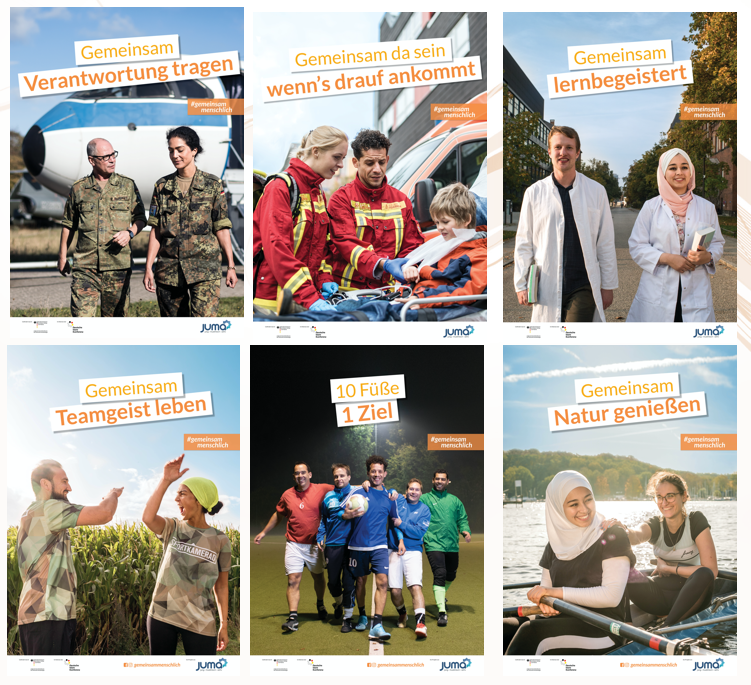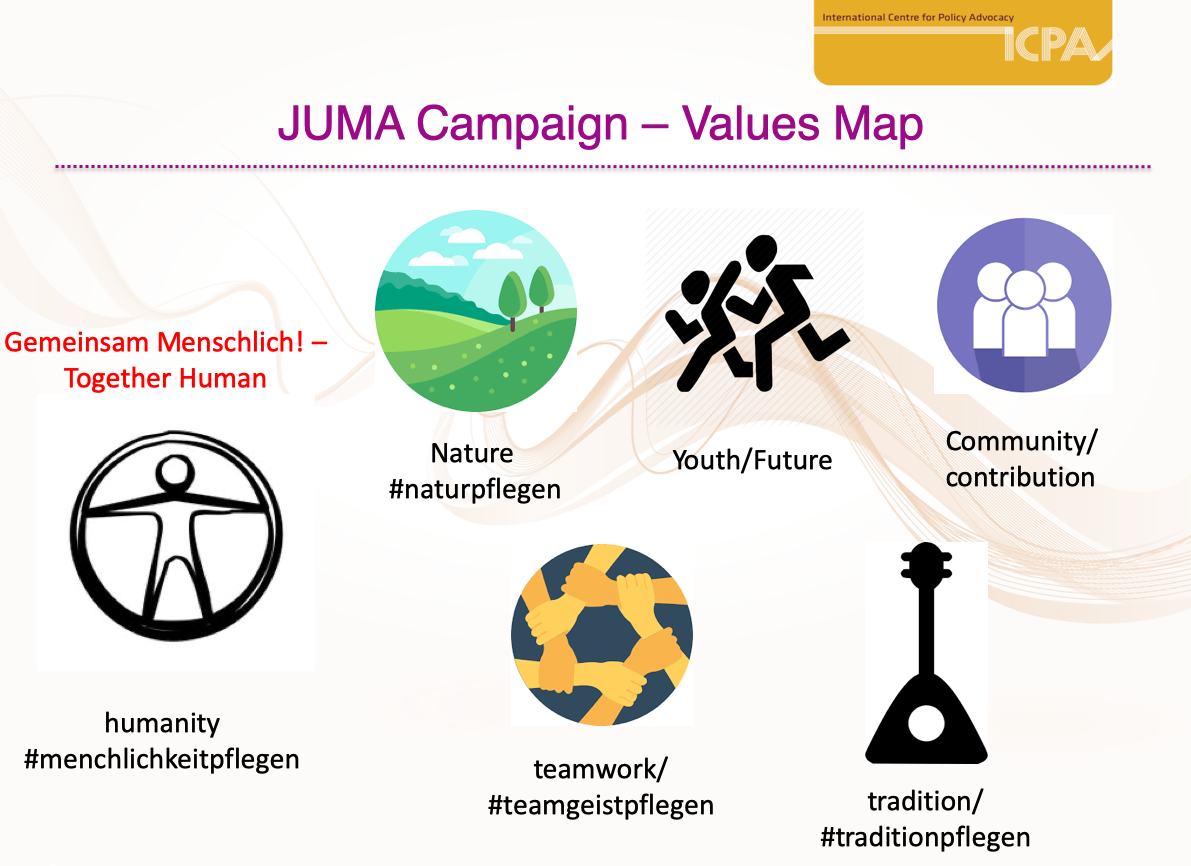Four Lessons I learned supporting the JUMA campaign (by Karim El-Helaifi)
2019 saw the launch of JUMA e.V’s “Together Human” campaign. Having supported campaign development in the Narrative Change Lab, I joined the campaign delivery team with a focus on creative content development. Here, I share 4 lessons I’ve taken from the experience.
Background: About the campaign
The “Together Human” (gemeinsam menschlich) campaign ran from 26 November to 7 December 2019. It aimed to reach audiences in the ‘movable middle’ of the migration debate in Berlin, Stuttgart and Leipzig. Specifically, to reach ‘economic pragmatists’ who believe that migrants make a useful economic contribution in Germany but are critical towards Islam and Muslims (see More in Common’s research). JUMA wanted to reinforce or ‘turn up’ the positive aspects of their opinions on migration and Muslims and ‘turn down’ or reduce their anxieties about Islam. The goal was to open the narrative space for new stories as a complementary tactic to JUMA’s important empowerment work.
The campaign addressed the fact that public debates, fuelled by extremist positions, distort the image of our society. They often focus on the differences between people. But actually, we share more than what separates us: values, experiences, and emotions, as friends, neighbours and work colleagues. The campaign conveyed this ‘common humanity’ message through a ‘show, not tell’ approach – sharing the stories of 3 protagonists, Säli, Ali and Nariman. It featured 12 pieces of creative social media content and street posters in Berlin, Stuttgart and Leipzig.

Image 1: The final 6 posters of the 3 protagonists in JUMA’s 'Together Human' campaign
Lesson 1: Stay true to your strategy
During strategy development JUMA went through the challenging process of finding the common values between them and the target group. The resulting value map became vital. It was the basis for all the decisions made after that point. As the creative development team, Nadia Wernli and I continually reflected on it, using the map to guide choices about the posters and films.

Image 2: The values map guiding the strategy of JUMA’s 'Together Human’ campaign
During the creation of the campaign content, you make hundreds of small decisions about wording, design, aesthetics and interviews. It is always tempting to lose sight of the target group and to implement what you (personally) find good. Nadia and I had to continually put ourselves in the shoes of ‘economic pragmatists’ and identify potential negative triggers. In the end it paid off: in both the testing and roll-out there was very little backlash, even from challenging audiences. Middle audiences shifted their opinions in a positive direction. Staying true to the strategy was worth it!
Lesson 2: The messenger is as important as the message
The protagonists of the campaign are its ambassadors. Therefore, protagonist selection is extremely important. You have to spend time on it.
We started with the value map and gathered ideas for protagonists who can authentically convey these values to our target group. Potential protagonists were then considered in detail: which values they embody, which “Together Human” moments they have in their everyday life, and which visual imagery could be used to convey this. We discussed whether there is enough diversity and at the same time a common thread that can be drawn between their stories.
Once we decided on Nariman, Ali and Säli, we set up 2-hour preliminary interviews with each of them. This allowed us to check if they were indeed a good fit and enabled us to plan possible poster motifs and film scenes. At first glance, this process is long and complex, but it made our work during the shoots and shootings immensely easier.
Lesson 3: Don't trust your instincts
I have already shared that we needed to put ourselves in the shoes of the target group. That is essential! But the fact is, I am not part of the target group and therefore might be wrong with my assumptions. This dilemma can be solved by one tool only: constant testing of the campaign content!
The value of testing before, during and after the creation of the campaign content is an important lesson for me. We used focus groups, A/B testing and a platform called Swayable to do tests of the campaign concept, draft content and near-final content. This helped us identify triggers for negative frames, to adjust our messages and order the waves of the campaign. Positive results from Swayable showing a 12% positive shift in opinions among the middle due to some of our videos a few weeks before campaign launch also gave us a much-needed confidence-boost!
Of course, testing costs money, but it is worth it. For me, every funding application for a campaign should include enough budget for testing. If you don’t have the resources for full testing, you could show the campaign content informally to potential members of the target group. As many practitioners say: any testing is better than no testing!
Lesson 4: Communication is as important as content
Once the campaign content has been created and tested, you can’t just sit back and relax. The actual campaign work is only the beginning. Communication of the content is just as important as the messages, posters and films themselves. The highest quality content will only achieve the desired effect if they reach the target group.
Achieving this requires a lot of careful planning and preparation: selecting communication channels and media, developing relationships with media and messengers, and preparing talking points. Unforeseen things can always happen so you need to be prepared for the best and worst case. You want to use your voice on- and off-line to build campaign momentum. The JUMA team had limited capacity in 2019 so we made the decision to focus more on developing quality content than on media partnerships for this round of the campaign. This meant that we didn’t get media coverage and our campaign reach was limited. It’s definitely something we’d like to improve for next time.
We are excited that our test campaign could show that the Narrative Change approach is working in Germany and that even smaller organisations like JUMA can play a role in opening the narrative space in public discourses. I would love to see this work lifted up to a bigger scale and embedded with a long-term perspective into wider networks.
About the author:
Karim El-Helaifi is an activist, spokesperson and writer. He is board member and spokesperson for ‘neue deutsche organisationen’1 (‘new German organisations’), a nationwide movement of NGOs that reflect Germany’s diversity and promote inclusion, and founding director of Schülerpaten2 . Karim supported the creative development of JUMA’s ‘Together Human’ campaign3 through ICPA’s Narrative Change Lab. He now works with ICPA on the project RESET: Building Strategic Communications to Reset Public Narratives on Islam in Germany4 , supporting German activists to build skills in this area.